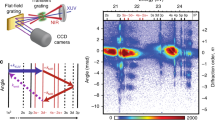Abstract
The general probe absorption coefficient derived in Part I is specialized to homogeneous- and inhomogeneous-broadening limits and illustrated as the dipole lifetime is increased from 0 to values comparable to the level lifetimes. This progression reveals the relation between pulsation dips of the short-dipole lifetime limit and the dynamic Stark effect in general. Interpretations of the coherent interactions involved are given in terms of modulator and Raman effects and of dressed atoms. The single-probe unidirectional pulsation dip is shown to be a special case of the grating dip in which the fringe spacing becomes infinite. Analogies with three-level systems are given in which both two and three-level cases are seen to obey an “equal-area theorem”, and to involve level crossing. Some comparison is made with corresponding spectroscopy in which spontaneous emission provides the probe radiation.
Similar content being viewed by others
References
M.SargentIII, P.E.Toschek, H.-G.Danielmeyer: Appl. Phys11, 55 (1976)
J.Hambenne, M.SargentIII: Phys. Rev. A13, 784 (1976)
E.V.Baklanov, V.P.Chebotayev: Zh. Eksp. Teor. Fiz.61, 922 (1971) [Sov. Phys. JETP34, 490 (1972)]
M.SargentIII: Appl. Phys.9, 127 (1976)
S.H.Autler, C.H.Townes: Phys. Rev.100, 703 (1955)
A.Schabert, R.Keil, P.E.Toschek: Appl. Phys.6, 181 (1975)
An equation reference like (I. 11) refers to Eq. (11) of Ref. 1
The population differenceD is traditionally taken to decay at the rate −D/T 1 to its equilibrium valueD eq in the absence of the applied field interaction contribution (represented by\(\dot D_v \)), that is,\(\dot D = - (D - D_{eq} )/T_1 + \dot D_v \). An upper level populationN a decaying with the rateγ a N a to a non-decaying ground lower levelb causes the populationN b to correspondingly increase at the same rate. Hence the population differenceD=N a −N b decays at double that rate, namely\(\dot D = - 2\gamma _a N_a + \dot D_v = - \gamma _a (D + N) + \dot D_v \), whereN=N a +N b . This givesT 1=1/γ a } andD eq=−N
M.Sargent III: “Relaxation of Hot Holes in p-Ge”, to be published
W.R.Bennett,Jr.: Phys. Rev.126, 580 (1962)
T.Hänsch, P.E.Toschek: IEEE J. Quant. Electr. QE-4, 530 (1968).
Gain has also been predicted with completely modulated light: see S.Feneuille, M.-G.Schweighofer, G.Oliver: J. Phys., to be published
M.SargentIII, M.O.Scully, W.E.Lamb,Jr.:Laser Physics (Addison-Wesley Publ. Co., Reading, Mass 1974) Chap. 9
M.SargentIII: InApplications of Lasers to Atomic and Molecular Physics, Proc. Les Houches Summer School, Ed. by R. Balian and S. Haroche (North-Holland Publ. Co., Amsterdam 1976)
P.E.Toschek: In——, Proc. Les Houches Summer School, Ed. by R. Balian and S. Haroche (North-Holland Publ. Co., Amsterdam 1976) Les Houches lectures, pp. cit., [14]
C.Cohen-Tannoudji: 1968Cargèse Lectures in Physics 2, Ed. M.Lévy (Gordon and Breach, New York)
S.Haroche: Ann. Phys. Paris6, 189 (1971). See also K.Kolwas, M.Kolwas: Opt. Comm.17, 149 (1976) for a treatment involving AM modulated light
S.Feneuille: J. Phys. B7, 1981 (1974), esp. Fig. 1
P.Pringsheim:Fluorescence and Phosphorescence, (Interscience Publishers, New York 1949)
W.Holzer, W.F.Murphey, H.J.Bernstein: J. Chem. Phys.52, 399 (1970)
For Δn 2>2, two interactions of the saturator light must take place consecutively, thus contributing only to ordinary saturation
L.S.Vasilenko, V.P.Chebotayev, A.V.Shishayev: Sov. Phys. JETP Lett.12, 161 (1970)
B.Cagnac, G.Grynberg, F.Biraben: J. de Physique34, 845 (1973)
E.V.Baklanov, V.P.Chebotayev: Zh. Eksp. Teor. Fiz.60, 552 (1971) [Sov. Phys. JETP33, 300 (1971)]
T.Hänsch, P.E.Toschek: Z. Physik236, 213 (1970)
J.B.Feldman, M.S.Feld: Phys. Rev. A5, 899 (1972)
J.B.Feldman, M.S.Feld: Phys. Rev. A12, 1013 (1975)
T.Yajima: J. Phys. Soc. Jap.16, 1594 (1961)
K.Shimoda, T.Shimizu: Progr. in Quantum Electronics2, 45 (1972)
H.R.Schlossberg, A.Javan: Phys. Rev.150, 267 (1966)
M.SargentIII, W.E.Lamb,Jr., R.L.Fork: Phys. Rev.164, 450 (1967)
B.Decomps, M.Dumont: Compt. Rend. B265, 249 (1967)
M.SargentIII: Phys. Rev. A14, 524 (1976)
See, e.g., G.W.Series: InQuantum Optics, Proc. Scottish Universities Summer School in Physics, 1969, Ed. by S.M.Kay and A.Maitland (Academic Press, New York 1970) p. 395
W.Hanle: Z. Physik30, 93 (1924)
G.W.Series: Proc. Phys. Soc.89, 1017 (1966)
W.Heitler:The Quantum Theory of Radiation (Oxford University Press, London 1954)
A.Smekal: Z. Physik34, 81 (1925)
This point in the context of saturation spectroscopy was called to our attention by Paul Liao. An outline of the diagonalization procedure was given in C.Cohen-Tannoudji, B.Diu, F.Laloë:Méchanique quantique, ComplémentF IV, Sec. 2b (Hermann, Paris 1973)
B.R.Mollow: Phys. Rev.188, 1969 (1969)
C.Cohen-Tannoudji: InLaser Spectroscopy, Proc. 2nd Intern. Laser Spectroscopy Conf., Megève, France, 1975 (Springer, Berlin, Heidelberg, New York 1975) p. 324
Author information
Authors and Affiliations
Additional information
Work performed as a Humboldt awardee in Germany.
Work supported in part by the Space and Missiles Systems Organization, Los Angeles, California.
Work supported by the Deutsche Forschungsgemeinschaft




